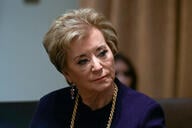You have /5 articles left.
Sign up for a free account or log in.
President Trump signed an executive order Tuesday re-establishing the White House Initiative on Historically Black Colleges and Universities and moving the initiative from the Department of Education to the Executive Office of the President.
Despite the serious hype that surrounded the order, including weeks of promising it would go beyond previous administrations' efforts, it offered no other concrete changes from previous orders, such as new funding commitments or contracting requirements by federal agencies. The executive order creates an advisory board (similar to that of past administrations) and also urges federal agencies to consider how they can better work with historically black colleges (as did previous presidential directives).
"It's a very important moment and a moment that means a great deal to me," Trump said.
The signing of the document followed weeks of discussions between White House advisers and advocates of HBCUs and two days of meetings and photo ops with college and university presidents in Washington.
Johnny C. Taylor Jr., president and CEO of the Thurgood Marshall College Fund, had sought commitments of specific funding levels from federal grants and contracts to HBCUs. And Taylor asked that the White House HBCU initiative be moved from the Department of Education to the White House. The organization had made both requests of the Obama administration.
Taylor in a statement said that the executive order was “a significant and positive first step” in the working relationship between historically black colleges and the new administration.
"We look forward to working with the executive branch and the legislative branch to ensure the president’s funding requests and the subsequent budget approved by Congress put the necessary resources into black colleges so they can continue doing the important work America needs them to do," Taylor said.
United Negro College Fund President and CEO Michael L. Lomax praised the decision to move the HBCU initiative into the White House but noted the group's funding recommendations were not included.
"Today, the president said he pledges to do more for HBCUs than any other president has done before, and we look forward to partnering with him to ensure this is a reality for the deserving students and faculty of HBCUs," Lomax said.
Trump hosted HBCU presidents in the Oval Office Monday, and on Tuesday they met with congressional Republicans in a daylong conference at the Library of Congress organized by Representative Mark Walker of North Carolina and Senator Tim Scott of South Carolina.
The high-level meetings represented heightened attention for black colleges -- particularly from Republicans. But not everyone saw much substance in the meetings that kicked off the visit to D.C.
Dillard University President Walter Kimbrough in a Medium post said the Oval Office trip scuttled other plans to meet with the heads of several federal agencies in addition to Education Secretary Betsy DeVos. That meant “there was very little listening to HBCU presidents,” he said.
Kimbrough said that given more time Monday, he would have emphasized the growing wealth gap between white and black households and the disparity in student loan debt between white and black college graduates. The best way to address those problems is to increase spending on Pell Grants, he said.
That was a common refrain among presidents in attendance at the HBCU “fly-in” hosted by Walker and Scott. And Pell Grants received verbal support, even from House Speaker Paul Ryan, who joined the two organizers for a live Facebook Q&A event.
But few details emerged on where funding for expanding Pell or other HBCU priorities would come from. Speaking with reporters at the event Tuesday, Scott said it was significant that members of the congressional appropriations committees were at the event, including Senator Marco Rubio, a Florida Republican.
“I’m not going to commit to a dollar amount unless it’s a dollar amount that I control,” Scott said.
HBCU leaders have other key funding priorities beyond Pell, including money for infrastructure and work force readiness.
But it’s unclear what impact Trump’s other budgetary plans could have on those goals. The White House said this week that Trump would ask Congress to add $54 billion in military spending, offset by spending cuts at other federal agencies.
Officials have not released any details on what cuts might be proposed for the Department of Education if it is among the affected agencies. DeVos said earlier in February that the department would look to identify unnecessary programs for cuts, prompting questions from Democratic leaders.
The education secretary spoke to HBCU leaders at the Library of Congress one day after sparking a controversy not over spending cuts but due to a statement that cast those institutions as “pioneers of school choice” and ignored the role racism played in their foundation. In her remarks Tuesday, DeVos said the history of HBCUs “was born, not out of mere choice, but out of necessity, in the face of racism, and in the aftermath of the Civil War.” The department did not respond to an inquiry about the anger over the initial statement.
In a less discussed section of her comments Monday, DeVos said institutions must be willing to make tangible, structural reforms rather than focus on questions of funding. But Taylor told reporters that those reforms can’t happen without improved funding for colleges and universities.
Despite the absence of firm commitments from the White House or congressional Republicans, Taylor said he was extremely optimistic about an improved relationship between the Trump administration and historically black colleges.
“This didn’t happen with an African-American president. We never saw that,” Taylor said. “And we didn’t see it before.”
The discussions with the Republicans on Capitol Hill happened against a backdrop of dissatisfaction on HBCU campuses, where many students and faculty members see their presidents being used or -- worse -- collaborating with an administration they see as hostile to their communities. In D.C. Tuesday, spray paint on Howard University’s Yard called campus President Wayne A. I. Frederick the “overseer” of the “Trump plantation.”
Julianne Malveaux, the former president of Bennett College in North Carolina, described herself as a dyed-in-the-wool Democrat with no love for Trump. But HBCU presidents “almost have to be there,” she said of meetings with Trump and Republican elected officials.
“The proof in the pudding is going be the dollars,” she said.
David Johns, the former executive director of the White House Initiative on Educational Excellence for African-Americans under President Obama, said conversations are essential to the policy-making process. But Johns, who has had conversations with Howard students critical of Trump, observed that the executive order came out late Tuesday afternoon, well after the White House's meetings with leaders of minority institutions -- and too late for those leaders to provide any feedback. That sequence of events was off for students who wanted to see what the university was getting for engaging with the administration, he said.
“If the question is, are these meetings -- or more crudely, photo opportunities -- translating into tangible resources for or otherwise advancing the needs of historically black colleges and universities? The answer right now is no,” Johns said.




